Arthrosis is a chronic joint disease in which joint cartilage is gradually destroyed.When the cartilage is destroyed, the changes arise in the bone that the cartilage covers and in the joint capsule.However, this description is not entirely accurate, because muscle disease in joints has some inflammatory changes.In English countries, "" Our joints in most cases are called arthritis (arthrithis), that is, arthritis (ITIS), while we are often called arthritis, joint damage in rheumatism.
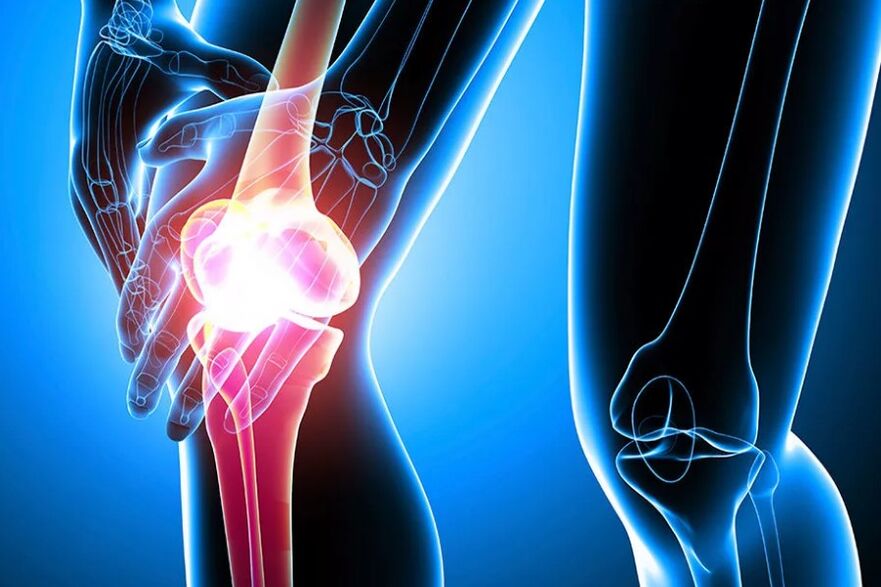
In modern scientific articles, the terms of osteoarthritis are often found (from Greek words, osteo osteo - bone, recovery - arthros, ie, no arthritis and bone disease).And again, in our English and English countries, our arthritis is called osteoarthrithis, ie arthritis and bone.In fact, arthritis and arthritis are synonymous, and your doctors have talked about the same.
As we have noted from the beginning, with arthritis (osteoarthritis), cartilage is gradually destroyed and the bone gradually participates in this process.With arthritis in the bone, part of hardening (compression) first occurs, due to the loss of shocking properties.After that, there are points along the edges of the bone (Exostosis), often called the wrong "
Salt sent
"- In fact, with conventional arthritis, no salt.With a more disease process, the bone begins to bend, deformed, cysts in which: Usually the disease is called
Define joints (joints).In the old health book, sometimes you can find the phrase "joint deformation", but now it is almost never used. biến dạng bệnh khớp (xương khớp). Trong sách y tế cũ, đôi khi bạn có thể tìm thấy cụm từ "biến dạng khớp", nhưng bây giờ nó gần như không bao giờ được sử dụng.
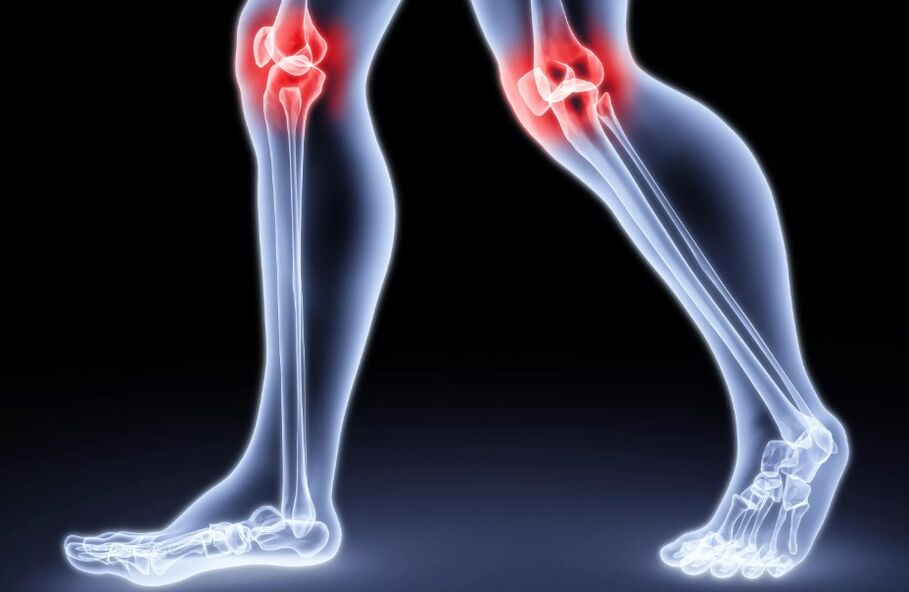
The exact causes of the development of muscle disease have been considered unknown for a long time, so there is another name for this disease - Definitely arthritis , ie Arthrosis, arising for unknown reasons or naturally.Of course, now scientists no longer consider muscle disease for a mystery and reasons for its development.More information about the causes of arthritis, primary arthritis and secondary arthritis below.Arthrosis of hip joints is called Coxarthrosis (slowly "COXA" - hip), ankle joints - Crurosteroarther ("cruuris" - lower leg), knee - knee - knee - knee - knee - knee -
Gonarthrosis ("Gene" - knee).In most cases, muscle disease affects both knee joints, while one of the joints may be more destroyed.In this case, the diagnosis may sound like a patient on both sides with the dominant lesions in the right knee (or left). Normally, not one, but some joints are influenced by arthritis, so they use another term -
Polyosteoarthrosis That means the failure of three or multiple joints (for example, two symmetry, both knees and others).In this case, the diagnosis is often heard as follows: Polyosteoarthrosis with predominant damage to knee joints (or one of them). Why does the knee joint happen?
Arthrosis of the knee joint is different.Depending on its cause, primary and secondary arthritis is distinguished.With age, the update of cartilage slows down and destroys cartilage, called the recession or degeneration, starting to win.
Bệnh viêm khớp nguyên phát của khớp gối
Sụn khớp liên tục bị phá hủy và cập nhật, và thông thường các quá trình này được cân bằng. Với tuổi tác, việc cập nhật sụn chậm lại và phá hủy sụn, được gọi là quá trình suy thoái hoặc thoái hóa, bắt đầu thắng thế.
The process of synthesizing and destroying cartilage is usually balanced.If degeneration begins to dominate, the knee joint will begin
In most cases, the degeneration of cartilage, meaning the development of arthritis, occurs after 45-50 years, but sometimes muscle disease can develop for 20 years.Fortunately, the development of arthritis at such a young age is extremely rare.
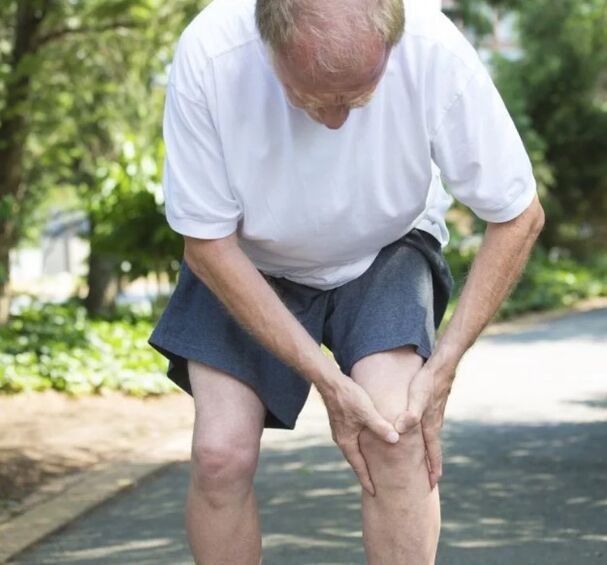
People are prone to knee arthritis at a larger or lower level.As a rule, if the joint occurs, only at the age of 40-60, and if at the age of 60, there is no muscle disease, it is likely that it will be no more, or more, joint disease will not be significant (some certain degenerative changes in the knee joint in all the elderly, but they are shown different).joints, but not all of them feel their knees are the problem.This is especially true for men who often suffer from serious arthritis that does not show themselves or cause minimum inconvenience.
Nguyen Phat joint disease occurs naturally, which is no boot elements, so it is called idiopathic, which we have said before.
Therefore, we have discovered that age is one of the main factors that determine the development of arthritis, because cartilage degenerative processes begin to dominate their age.Each fourth person is over 55 years old with knee arthritis.But we also note that with age, muscle disease does not develop in everyone.Therefore, there are other reasons.Before we list them, we note that there is no main reason.The arthritis of the knee joint develops in terms of the cause, while some play a big role, while others - less.
Floor. More often, women of the knee joint suffered by women.The exact reasons for this are unknown, but you can try to explain the following reasons.On average, the life expectancy of women is greater than men, and accordingly, the average elderly woman will show more degenerative processes.In addition, body weight in women is a bit higher.The size of the bone in women is smaller than in men, and, along with higher body weight, which leads to higher pressure in the knee joint, and thereby, the stronger mechanical destruction of cartilage.In most cases in women, arthritis begins to appear after menstruation, and, maybe, the deficiency of estrogen determines the development of arthritis.Note that the efforts to treat knee joints in women after menopause by estrogen, of course, are done, but so far they have not succeeded.
Weight. Of course, the greater the body weight, the greater the load must be transferred to our knee joint.In addition, overweight reduces physical activity and leads to the weakness of the hip muscles.For more active synthesis of cartilage, the movement (no need for excessive pressure) is necessary and with a sedentary lifestyle, the process of cartilage cartridges begin to dominate.The hip muscles are important stabilizers of the knee joint, and with the weakness of these muscles, the movement in the knee joint becomes more painted, increasing the speed of destroying cartilage.In general, these processes can be described as a vicious cycle: the greater the body weight, the faster the knee joint, the greater the pain, the harder it is, the harder it is to move, again leading to excess body weight.

The vicious circle of obesity and joints of the knee joint
On the other hand, only the joint disease of the knee joint only develops in complete people - those without obesity can also have arthritis.Again, this is because muscle disease has no reason.
Genetics. For a long time, it has been aware that Arthricis of the knee joint is a "family disease".If you have muscle disease or parents, it is unfortunate, the probability of this disease is high for you.Scientists have discovered many genetic characteristics responsible, for example, the individual characteristics of the structure of the main cartridge of cartilage - collagen, but, unfortunately, so far these discoveries are not realistic, because we cannot affect the prevention or treatment of muscle diseases.There is evidence that the inheritance of muscle disease is transmitted along the female line, which explains a part of their big trend for this disease.
Nguyen Phat arthritis of the knee joint does not only occur for a reason, but only by their total number.At the same time, the knee joint is at one degree or the other level of most people over 60 years old, but the severity of arthritis is very different, and is not always found on X -rays.In fact, it is even more difficult: there is no pain in the knee joint in the elderly or more, at the age of 40-60 will come with changes in the X-ray characteristics of arthritis.
For example, scientists have discovered that 76% of the elderly have complaints about knee pain on X -ray to find joint disease. That is, without any pain in the knee joint in the elderly, it must be the joint of the knee joint. At the same time, among all the elderly people with the joints of the knee joints found on X -ray, only 81% will complain about pain. That is, not always joint pain:It occurs that changes on X -rays are completely negligible, and the pain is very strong, and it occurs in a different way: the joint is completely destroyed on the X -ray, and a person can ride a bike, participate in yoga, work as a malarus and such cases we meet almost every day.The blue arrow marks the outer part of the joint and orange - the inside.Pay attention to the distance between bones from the inside: cartilage cannot be seen on X -ray and that is this distance means cartilage.In this case, in fact, there is no cartilage inside the knee joint and bones were rubbed on the bone.Because arthritis often affects both knee joints, that is, it is bilateral, both legs begin to be twisted and O -shaped foot deformity (deformed deformation).
Nói đúng ra, không có mối liên hệ bắt buộc nào về mức độ nghiêm trọng của cơn đau với mức độ nghiêm trọng của bệnh viêm khớp của khớp gối trên X quang. Nó xảy ra rằng những thay đổi trên X quang là hoàn toàn không đáng kể, và nỗi đau rất mạnh, và nó xảy ra theo cách khác: khớp bị phá hủy hoàn toàn trên X quang, và một người có thể đi xe đạp, tham gia yoga, làm việc như một malarus và những trường hợp như vậy chúng tôi gặp gần như mỗi ngày.
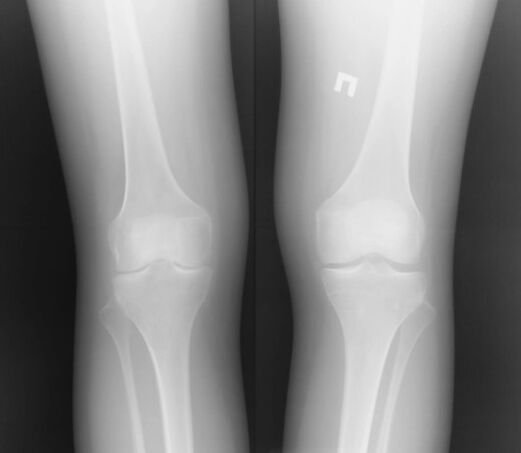
Thường xuyên hơn, bệnh khớp đầu gối bắt đầu với bộ phận nội bộ (trung gian).
X quang của khớp gối bị ảnh hưởng bởi bệnh viêm khớp từ bên trong. Mũi tên màu xanh đánh dấu phần bên ngoài của khớp và màu cam - bên trong khớp. Hãy chú ý đến việc khoảng cách giữa các xương từ bên trong: sụn không thể nhìn thấy trên X quang và đó là khoảng cách này có nghĩa là sụn. Trong trường hợp này, thực tế không còn sụn ở bên trong khớp gối và xương đã bị cọ xát trên xương.
Với sự mài mòn dần dần của sụn từ bên trong khớp gối, chân bắt đầu uốn cong. Vì bệnh viêm khớp thường ảnh hưởng đến cả hai khớp gối, nghĩa là, nó là song phương, cả hai chân bắt đầu bị xoắn và xảy ra biến dạng bàn chân hình chữ O (biến dạng biến đổi).
Ít phổ biến hơn (trong khoảng 10% trường hợp), các phần bên ngoài của khớp bị ảnh hưởng bởi bệnh viêm khớp và trong trường hợp này là biến dạng hình X (valgus) bắt đầu.
Of course, with curvature, loads on internal deformation variants (O) or external or external (with Figure X) even more increased, and Arthrosis will grow faster and cannot be canceled.This option is called patella arthritis and it occurs, according to the regulations, due to
Tilt, Sess Subluxation of a model, hypertension syndrome that a separate article is reserved on our website or after Paen "fracture , which you can also read in a separate article. Secondary arthritis of knee joints
The knee joint can also develop due to any specific cause, in this case, arthritis is called secondary.Now we will briefly talk about the options for secondary arthritis.
Post -traumatic Arthrosis of the knee joint.
Of course, the knee injuries do not add a joint in health and almost all of them, in one way or another, increases the risk of arthritis.Unfortunately, anyone with the distance of cartilage has been able to develop arthritis.If an intermediate cartilage (inside) is damaged, muscle disease will develop inside the knee joint.And, accordingly, if the outside cartilage is broken, arthritis will develop in the outer joint of the joint.Note that the broken cartilage does not necessarily lead to arthritis, its probability of development.Of course, the more damaged cartilage, the higher the risk of arthritis.
Một trong những chấn thương phổ biến nhất của khớp gối là sự vỡ của senisci, được dành cho một bài viết riêng trên trang web của chúng tôi. Thật không may, bất kỳ người nào có khoảng cách của sụn đã từng có khả năng phát triển bệnh viêm khớp. Nếu một sụn trung gian (bên trong) bị tổn thương, thì bệnh cơ sẽ phát triển ở bên trong khớp gối. Và, theo đó, nếu sụn bên ngoài vỡ, thì bệnh viêm khớp sẽ phát triển ở khớp bên ngoài của khớp. Lưu ý rằng sự vỡ của sụn không nhất thiết phải dẫn đến bệnh viêm khớp, xác suất phát triển của nó. Tất nhiên, càng nhiều sụn bị tổn thương, nguy cơ mắc bệnh viêm khớp càng cao.
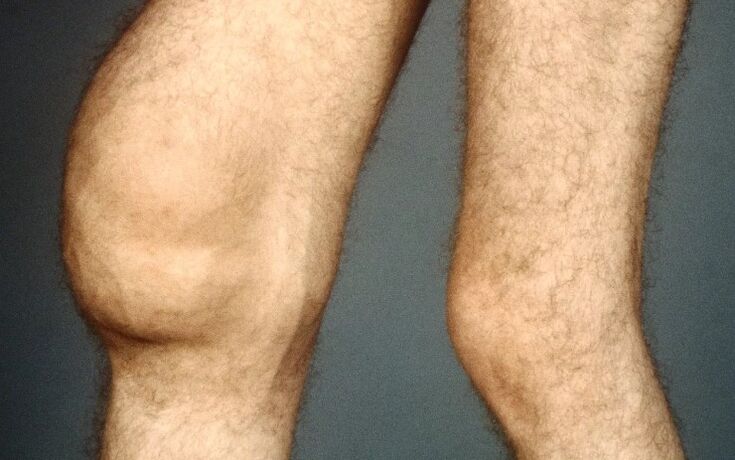
Another reason for the development of knee joint disease is the ligament rupture, for example, a rupture of the front ligament.Due to the broken ligament in the joints, the instability may appear, of course, will lead to damage to cartilage and the development of arthritis.Naturally, cartilage damage depends on the level of unstable, may vary.Almost any inner fracture comes with the movement of pieces, and therefore, the shape of the joint surface changes.The step appears is the result of a certain change that leads to the destruction of cartilage progression and the appearance of arthritis.Of course, the heavier the fracture, the greater the intracranial fracture, the more damaged the cartilage and the higher the risk of arthritis.After the severe diverse fractures of the tibia, Arthrosis disease develops in nearly 100% of cases even when bone synthesis is performed perfectly (removing bone pieces and tied with screws, sheets, etc.)

















































